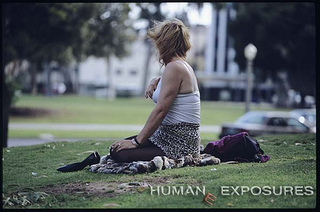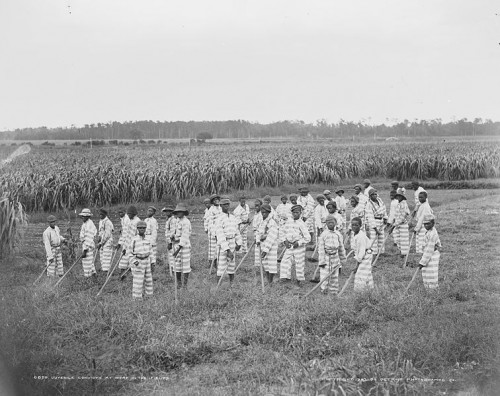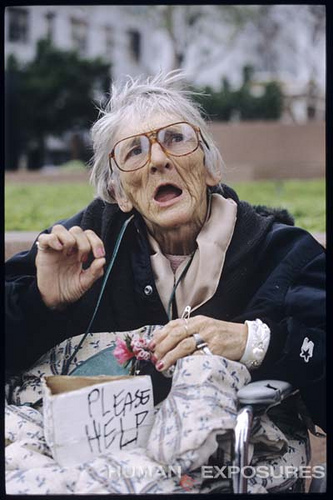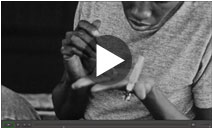
Tutweiler Prison. Photo from Wikipedia
On January 17, 2014, the U.S. Department of Justice released a report of the findings of its investigation into the allegations of ongoing sexual abuse of inmates by prison guards at the Julia Tutweiler Prison for Women in Wetumka, Alabama. It found that the State of Alabama grievously violates the Eighth Amendment of the United States Constitution by failing to protect women prisoners at Tutwiler from harm due to sexual abuse and harassment from correctional staff.
The DOJ report stated:
Tutwiler has a history of unabated staff-on-prisoner sexual abuse and harassment. The women at Tutwiler universally fear for their safety. They live in a sexualized environment with repeated and open sexual behavior, including: abusive sexual contact between staff and prisoners; sexualized activity, including a strip show condoned by staff; profane and unprofessional sexualized language and harassment; and deliberate cross-gender viewing of prisoners showering, (and using the toilet).
Officials at the Alabama Department of Corrections (ADOC) and Tutwiler have failed to remedy the myriad systemic causes of harm to the women prisoners, despite repeated notification of the problems and have demonstrated a clear, deliberate indifference to the harm and substantial risk of harm to women prisoners. They have failed to take reasonable steps to protect people in their custody from the known and readily apparent threat of sexual abuse and sexual harassment.
Officials have been on notice for over 18 years of the risks to women prisoners and, for over 18 years, have chosen to ignore them. In 2003, Tutwiler deigned for 400 inmates, housed 992 women when a U.S. District Judge found that its overcrowded, underfunded conditions were so poor that they violated the U.S. Constitution. In 2012 the Equal Justice Initiative (EJI), a nonprofit that provides legal representation to indigent defendants and prisoners, filed a formal complaint with the U.S. Department of Justice saying that in interviews with more than 50 women, it found evidence of frequent and severe officer-on-inmate sexual violence.
In May 2013, Mother Jones magazine reported that Julia Tutwiler ranked as one of the 10 worst prisons in the United States. Despite years of complaints against Tutweiler and the DOJ investigation, appetite for costly reform appears minimal in Alabama, while conditions remain horrible and prisoners are still fearful.
The report continued:
For nearly two decades, Tutwiler staff have harmed women in their care with impunity by sexually abusing and sexually harassing them. Staff have raped, sodomized, fondled and exposed themselves to prisoners. They have coerced prisoners to engage in oral sex. Staff engage in voyeurism, forcing women to disrobe and watching them while they use the shower and use the toilet.
Prison officials have failed to curb the sexual abuse and sexual harassment, despite possessing actual knowledge of the harm, including a federal statistical analysis identifying sexual misconduct at Tutwiler as occurring at one of the highest rates in the country.
Of the 233 prisoner letters the DOJ investigation received, 44 alleged pervasive sexual abuse and harassment. Investigators received numerous reports of many staff engaging in prohibited sexual contact with prisoners. At least 36 of the 99 total employees were identified as having had sex with prisoners. If you include staff identified for other forms of sexual abuse and sexual harassment, the number of staff involved nearly doubles. In some cases, prisoners describe the misconduct as non-consensual, unwelcome and/or the result of physical force. In other cases prisoners were pressured into “consensual sex “ (still illegal) by threats or by promises of gifts or privileges,
Following the release of a damning 2007 report, ADOC officials failed to implement operational practices to address the issue of sexual abuse at Tutwiler. Instead, officials allow staff to continue to retaliate against women who made allegations relating to sexual misconduct. ADOC also failed to adequately respond to or investigate allegations and failed to properly discipline staff found to have engaged in sexual abuse or harassment. These actions and inactions, when combined with the various systemic deficiencies at Tutwiler, violate the law and foster an environment where additional sexual abuse can occur.
In both 2007 and 2013, sexual abuse at Tutwiler was woefully underreported. Many prisoners confirmed this, citing fear of retaliation as a reason for not reporting sexual abuse and harassment. EJI provided multiple examples of women who, after reporting sexual abuse, were placed in segregation with limited or no access to a telephone, visitors or programs, for an extended time. Prison officials treated these women with the presumption that they were lying, subjecting them to polygraph examinations as a prerequisite to investigating allegations. Staff verbally harassed them for reporting allegations of sexual abuse involving their colleagues.
The 2014 DOJ report observed that Tutweiler’s long and unabated history of staff sexual abuse and harassment is facilitated by a disciplinary system that fails to substantiate the conduct of, and discipline, sexual predators. Tutwiler fails to adequately manage and analyze existing data to identify potential sexual misconduct and problematic staff behavior. As a result, officers who are identified in several prisoners’ allegations are not flagged for further review and are less likely to be disciplined and prevented from further abuse. After the prisoners who file those reports see the officers remain on the unit, they decide that reporting is futile.
Staff and prisoners continued to engage in overt and inappropriate sexual behavior at Tutwiler within days of investigators’ recent arrival. This behavior underscores the need for numerous critical institutional reforms that will not only address the underlining causes of the harm, but also identify and implement sustainable reforms. To this end, the report concluded, ADOC must take on an active role in monitoring the changes made at Tutwiler, because it is no longer enough to delegate the changes to the Tutwiler officials without expansive oversight.
The report insists that order to rectify the deficiencies identified in this investigation, ADOC and Tutwiler should implement, at a minimum, the following 24 remedial measures:
1) Comply with all provisions of the National Standards to Prevent, Detect, and Respond to Prison Rape as promulgated by the United States Department of Justice;
2) provide multiple internal methods for prisoners to privately report sexual abuse and sexual harassment, allowing the resident to remain anonymous upon request;
3) protect all prisoners who report sexual abuse or sexual harassment or cooperate with sexual abuse or sexual harassment investigations from retaliation by other prisoners or staff, while designating which staff members or departments are charged with monitoring retaliation;
4) provide a method for staff to privately report sexual abuse and sexual harassment of prisoners;
5) ensure that an administrative and/or criminal investigation is completed for all allegations of sexual abuse and sexual harassment;
6) prepare a written report of its investigative findings for each investigation;
7) establish guidelines for timely and thorough investigations and develop a process for monitoring those timelines, while ensuring that investigations not solely rely on polygraph examinations and Tutwiler not require a prisoner to submit to a polygraph examination as a condition for proceeding with an investigation;
8) ensure that all allegations of sexual abuse or sexual harassment are properly labeled and tracked;
9) have a written policy mandating zero tolerance toward all forms of sexual abuse and sexual harassment and outlining their approach to preventing, detecting and responding to misconduct;
10) develop and implement a detailed policy on prevention, detection, reporting and investigation of sexual abuse, including prisoner-on-prisoner and staff-on-prisoner sexual abuse;
11) develop a written, institution-specific plan to coordinate actions taken in response to an incident of sexual abuse, among staff first responders, medical and mental health practitioners, investigators and facility leadership, including timelines and lists of whom staff should contact in specific situations;
12) implement policies and procedures that enable prisoners to shower, use the bathroom, and change clothing without non-medical staff of the opposite gender viewing them, and requiring staff of the opposite gender to announce their presence when entering a prisoner-housing unit;
13) implement policies and procedures regarding the management of LGBT and gender- nonconforming prisoners;
14) ensure that all newly admitted prisoners receive information in their native language, through a prisoner handbook and, at the discretion of ADOC and Tutwiler, an orientation video, regarding the following: facility rules and regulations, definitions of sexual abuse and sexual harassment, how to report misconduct, how to report sexual abuse and sexual harassment, the process for accessing medical and mental health care, the disciplinary process and how to access the grievance process once it is developed;
15) collect, consolidate, analyze, track and otherwise use its data, including incident reports and grievances, to identify sexual abuse and sexual harassment and problematic staff behavior;
16) develop and implement an adequate grievance process;
17) ensure that a prisoner who alleges sexual abuse or sexual harassment may submit a grievance without having to give it to a staff member who is the subject of the complaint; 18) ensure that Tutwiler develop, implement, and document a staffing plan, based on gender-responsive principles, that provides for adequate levels of staffing, and, where applicable, real-time video monitoring, to protect prisoners against sexual abuse;
19) develop a plan to recruit additional women correctional officers;
20) establish a policy to ensure that any employee, contractor or volunteer who is suspected of sexual abuse or sexual harassment does not interact with prisoners until an investigation is concluded;
21) provide appropriate orientation, basic and in-service training to all employees who may have contact with prisoners;
22) address architectural features that contribute to a lack of privacy for prisoners while showering or using the bathroom, and conduct an assessment to identify physical plant vulnerabilities, including blind-spots within the facility, that could contribute to sexual misconduct;
23) implement a gender-normed classification system specific to women prisoners at Tutwiler; and
24 implement a risk-assessment process that adequately identifies potential predators and victims.




![thumb_dollar_sign_BW[1]](http://humaneexposures.com/blog/wp-content/uploads/2014/05/thumb_dollar_sign_BW1.png)














